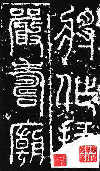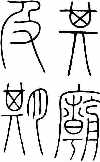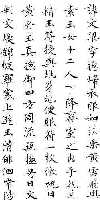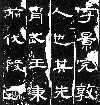THE ART OF WRITING: CHINESE CALLIGRAPHY
Chinese calligraphy is an art of selfcultivation and self-expression. It reflects the mindset and mood of the writer, and fully embodies the unique beauty of Chinese script. Today, Chinese calligraphy is enjoyed by people throughout the world.
 |
Xiaozhuan (small seal): Evolving from Dazhuan (Big Seal) of the Qin Fiefdom, Xiaozhuan was simplified and standardized to become more even in size and smooth in line. Emperor Qin decreed this style of script be used nationwide after his unification of China (221 B.C.). |
 |
Xiaozhuan (small seal): Evolving from Dazhuan (Big Seal) of the Qin Fiefdom, Xiaozhuan was simplified and standardized to become more even in size and smooth in line. Emperor Qin decreed this style of script be used nationwide after his unification of China (221 B.C.). |
 |
Caoshu(Cursive Script): Literally meaning "grass", this script is uniquely simple and free in style. There are three kinds of Caoshu: Zhangcao (Draft Cursive), created in the Han Dynasty (206 B.C.- 220 A.D.) as a simplification of Lishu; and Jincao (Modern Cursive) and Kuangcao (Wild Cursive), both evolving from kaishu, and created respectively in the Wei and Jin periods (220-420 A.D.) and the Tang Dynasty(618-907 A.D.). |
 |
Xingshu (Semi-curisive): Nicknamed "Running Script," this style of calligraphy marks the transition between Kaishu and Caoshu in terms of its ability to be written quickly. It originated in the Han Dynasty (206 B.C. - 220 A.D.), and became mature in the Wei and Jin periods and the Southern and Northern Dynasties (220 - 589). |
\ |
Kaishu (standard script): A further evolution from Lishu, Jaishu is distinguishable by its straight lines and square shape. This style of writing has been widely used since the Han Dynasty (206 B.C. - 220 A.D.), and continues to be popular today. |
 |
Kaishu (standard script): A further evolution from Lishu, Jaishu is distinguishable by its straight lines and square shape. This style of writing has been widely used since the Han Dynasty (206 B.C. - 220 A.D.), and continues to be popular today.
|
 |
Lishu (Clerical Script): An easier style of writing evolving from Xiaozhuan, Lishu is characterized by its flatness and the replacement of rounded edges with angled ones. It was initiated in the Qin Dynasty (221 - 206 B.C.) and widespred in the Han Dynasty (206 B.C. - 220 A.D.)
|
 |
Lishu (Clerical Script): An easier style of writing evolving from Xiaozhuan, Lishu is characterized by its flatness and the replacement of rounded edges with angled ones. It was initiated in the Qin Dynasty (221 - 206 B.C.) and widespred in the Han Dynasty (206 B.C. - 220 A.D.)
|
 |
Lishu (Clerical Script): An easier style of writing evolving from Xiaozhuan, Lishu is characterized by its flatness and the replacement of rounded edges with angled ones. It was initiated in the Qin Dynasty (221 - 206 B.C.) and widespred in the Han Dynasty (206 B.C. - 220 A.D.)
|









